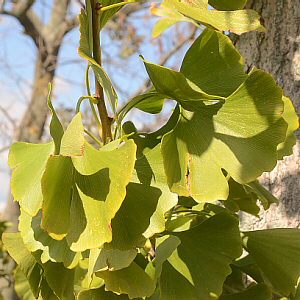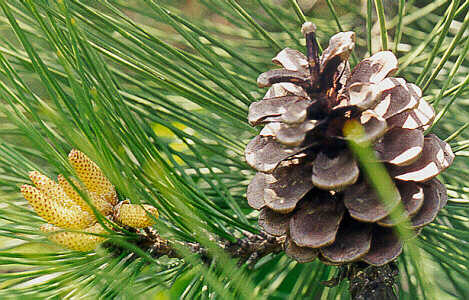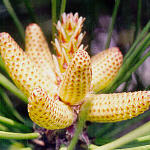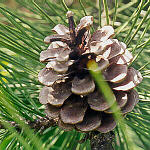
Click for More Cycad Photos

Ginkgo Leaves

Click for More Pine Photos
As land-dwelling plants developed further past ferns, several modifications were developed for water conservation. These included:



Pine is the most commonly-studied example of a gymnosperm.

In pine as in other vascular plants, the sporophyte is the dominant generation. It consists of an underground network of roots supporting an upright stem, the trunk, which bears whorls of branches. The needles (leaves) typically occur in clusters of two or more. The sporophyte bears two types of reproductive structures referred to as “male” and “female” cones. Each cone is considered to be a modified branch with a number of modified leaves, called scales or sporophylls. Each sporophyll bears a structure called a sporangium in which the spores are produced. Unlike the ferns, in gymnosperms the spores as well as the gametes come in two sizes: separate microspores and megaspores (micro = small; mega = large, great) are produced in separate sporangia and develop into male and female gametophytes, respectively.

“Male” Pine Cones

Pine Pollen
The “male” cones typically are found in clusters at the tips of lower, side
branches, and usually take several years to develop. In these cones, the
modified leaves are called microsporophylls. Each microsporophyll
bears a microsporangium in which the microspores are produced.
Still inside the microsporangium, each microspore divides and “grows” to
form a four-celled (four nuclei, anyway) male gametophyte, also known
as pollen which contains two sperm nuclei. A grain of pine
pollen also has two large air sacs to make it buoyant in the wind, and these
give the pollen a “Mickey Mouse hat” appearance.
Pollination is the transfer of the whole male gametophyte to the female plant. In pine, the pollen is blown by wind. Note that this is NOT the equivalent of fertilization — that must still occur later!

“Female” Pine Cones
The female cones typically form higher up in the tree, and also usually take
several years to develop. Their modified leaves/scales are called
megasporophylls and produce megaspores. Each scale
(megasporophyll) has two areas (megasporangia or ovules) where
megaspores can develop. Each ovule has a micropyle (pyle =
gate, orifice), a small hole in the near end of the ovule wall so the sperm
can enter.
When a pollen grain lodges between the “stem” of the female cone and a megasporophyll/ovule, we say that pollination has occurred. Then, to accomplish fertilization, a tube from the pollen (called a pollen tube) grows into the micropyle, then into the female structures. This stimulates production of the actual megaspore by the female. The megaspore develops/“grows” into a female gametophyte and (like other female gametophytes) produces a few archegonia, each with an egg in it. The pollen forms two sperm nuclei which travel up the pollen tube toward the archegonia. Eventually one of these sperm nuclei fertilizes one of the eggs in one of the archegonia in each of the ovules. The other sperm nucleus and all other eggs and archegonia in that female gametophyte disintegrate so one zygote per ovule is left.
From the zygote, cells divide and grow into an embryo sporophyte (2n). This forms in the middle of a female gametophyte (1n) which serves as its first food. Typically, parts of the old megasporophyll from the parent pinecone (2n) form a protective seed coat and the “wing” for dispersal.

Torrey Pines Sprouting
When the seed is mature or ripe, it separates from the female
cone and is carried by the wind to a new location. When the seed germinates,
the embryo continues to grow into a new pine tree. Initially, it uses the
nutrients provided by the female gametophyte until its first leaves are above
ground and large enough to do photosynthesis.